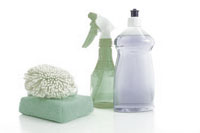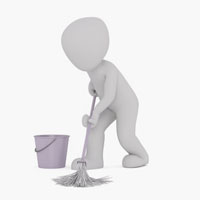Not many products that were invented over 100 years ago are still as widely used as the mop. The mop was invented in 1893 and it wasn’t until 57 years later that we saw the sponge mop, so it must be doing something right. With all things involving cleaning floors, there are ways to increase productivity and sanitation. It doesn’t make sense to attempt cleaning the floor by putting a mop into dirty water and then sloshing that mop around the floor. What you can do, short of buying an auto scrubber, is take note of some tips and facts about the old mop and bucket technique:
- First, some bad news... mops are not the most effective way to clean large, high traffic facilities like hospitals and schools because they have too much bacteria that can cross-contaminate other areas. In just 10 minutes, a disinfectant’s efficacy can be reduced by 50%. Here is a brief explanation of how cleaning detergents work:
- Surfactant molecules (found in cleaning detergents) have a structure where one end attaches to water and
 the other end attaches to the grease or dirt – something water simply cannot do because of its structure. These dirt-loving molecule ends attach themselves to the dirt or grease and the movement of the mop (on the floor and in the bucket) breaks the dirt down making it easier to remove. When rinsed, the water molecules attach to the other end of the surfactant molecules, pulling dirt and detergent away. You’ll also find enzymes in chemical detergents to assist in breaking up more stubborn grime and stains.
the other end attaches to the grease or dirt – something water simply cannot do because of its structure. These dirt-loving molecule ends attach themselves to the dirt or grease and the movement of the mop (on the floor and in the bucket) breaks the dirt down making it easier to remove. When rinsed, the water molecules attach to the other end of the surfactant molecules, pulling dirt and detergent away. You’ll also find enzymes in chemical detergents to assist in breaking up more stubborn grime and stains.
- Surfactant molecules (found in cleaning detergents) have a structure where one end attaches to water and
- Chalk or powdery substances are not the mop’s strong suit since they can result in a thick paste once mixed with liquids. You may also run into some common issues like floor streaking, slippery and tacky spots, hazy or cloud appearance, and water spotting. You can generally take care of those problems by going over those areas again with clean water and detergent.
- The good news is that mops are still an efficient way to clean dried up liquids, grease, and soils in small spaces utilizing the 2 bucket method – one for rinsing and the other for cleaning solution. It is a good rule of thumb to wring out your mop every 100 square feet. The mop head will be dirty the second time you put it into the bucket. Changing the
 mop head after every room cleaned is imperative but is a difficult task to supervise. Another important activity to take note of is vacuuming or sweeping BEFORE mopping.
mop head after every room cleaned is imperative but is a difficult task to supervise. Another important activity to take note of is vacuuming or sweeping BEFORE mopping. - There is no easy way to estimate the square footage that will be cleaned with a mop bucket for several reasons – 1. A large bucket has more room to dilute soils but doesn’t work well in a heavily soiled area because you’ll empty the bucket more often to reduce cross-contamination, 2. For smaller establishments, a large bucket can waste water and requires more cleaning detergent but a small bucket means more time spent travelling to the water source, 3. Larger establishments typically have more traffic and soils but a larger bucket doesn’t mean the water needs changing any less. Changing mop water really depends on how dirty the floor is and as easy as it sounds – how dirty the water looks!
- A recommended mopping method is where you put about 36”-48” square inches of clean detergent/water solution on the floor with the mop (don’t swish yet!) and then ring the mop out in the dirty water bucket. Next, you take the freshly wrung out mop and swish the mop back and forth no more than 3 times - after 3 swishes you’re just moving dirty water around.
- The fact that it is not recommended to wash cotton/polyester fiber mops and they are laborious to clean supports the case for using a microfiber mop head. Microfiber mop heads can help prevent cross-contamination and last up to 500 machine washes (about 5 years) with consistent use. To extend the life of a mop head it is recommended to change the mop head after every 500 square feet cleaned and wash with a gentle detergent and dried on low heat.
- When choosing a mop, look for one that is constructed of sturdy and durable materials. As for the mop head, a loop-end mop is lint-free and doesn’t tangle. A narrow mop head can reach into tight spaces and is very efficient. Remember, microfiber is easier to clean and more capable than its cotton/polyester counterparts but cotton is more affordable and made for heavier-duty applications.
While the mop and bucket technique can be upgraded, it is still a viable way to clean floors if done correctly. Not changing the water regularly or wringing out the mop head will increase the amount of bacteria on the floors. Follow the instructions on any mop you purchase as well as consider the important notes we’ve outlined above. And don’t forget to choose the appropriate cleaning detergent!

